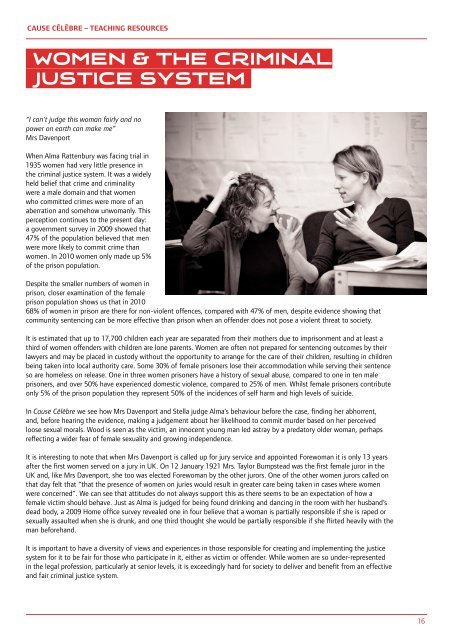Cause Celebre - IdeasTap
Cause Celebre - IdeasTap
Cause Celebre - IdeasTap
Create successful ePaper yourself
Turn your PDF publications into a flip-book with our unique Google optimized e-Paper software.
CAUSE CélèBRE – TEACHINg RESOURCES<br />
Women & the Criminal<br />
Justice System<br />
“I can’t judge this woman fairly and no<br />
power on earth can make me”<br />
Mrs Davenport<br />
When Alma Rattenbury was facing trial in<br />
1935 women had very little presence in<br />
the criminal justice system. It was a widely<br />
held belief that crime and criminality<br />
were a male domain and that women<br />
who committed crimes were more of an<br />
aberration and somehow unwomanly. This<br />
perception continues to the present day:<br />
a government survey in 2009 showed that<br />
47% of the population believed that men<br />
were more likely to commit crime than<br />
women. In 2010 women only made up 5%<br />
of the prison population.<br />
Despite the smaller numbers of women in<br />
prison, closer examination of the female<br />
prison population shows us that in 2010<br />
68% of women in prison are there for non-violent offences, compared with 47% of men, despite evidence showing that<br />
community sentencing can be more effective than prison when an offender does not pose a violent threat to society.<br />
It is estimated that up to 17,700 children each year are separated from their mothers due to imprisonment and at least a<br />
third of women offenders with children are lone parents. Women are often not prepared for sentencing outcomes by their<br />
lawyers and may be placed in custody without the opportunity to arrange for the care of their children, resulting in children<br />
being taken into local authority care. Some 30% of female prisoners lose their accommodation while serving their sentence<br />
so are homeless on release. One in three women prisoners have a history of sexual abuse, compared to one in ten male<br />
prisoners, and over 50% have experienced domestic violence, compared to 25% of men. Whilst female prisoners contribute<br />
only 5% of the prison population they represent 50% of the incidences of self harm and high levels of suicide.<br />
In <strong>Cause</strong> Célèbre we see how Mrs Davenport and Stella judge Alma’s behaviour before the case, finding her abhorrent,<br />
and, before hearing the evidence, making a judgement about her likelihood to commit murder based on her perceived<br />
loose sexual morals. Wood is seen as the victim, an innocent young man led astray by a predatory older woman, perhaps<br />
reflecting a wider fear of female sexuality and growing independence.<br />
It is interesting to note that when Mrs Davenport is called up for jury service and appointed Forewoman it is only 13 years<br />
after the first women served on a jury in UK. On 12 January 1921 Mrs. Taylor Bumpstead was the first female juror in the<br />
UK and, like Mrs Davenport, she too was elected Forewoman by the other jurors. One of the other women jurors called on<br />
that day felt that “that the presence of women on juries would result in greater care being taken in cases where women<br />
were concerned”. We can see that attitudes do not always support this as there seems to be an expectation of how a<br />
female victim should behave. Just as Alma is judged for being found drinking and dancing in the room with her husband’s<br />
dead body, a 2009 Home office survey revealed one in four believe that a woman is partially responsible if she is raped or<br />
sexually assaulted when she is drunk, and one third thought she would be partially responsible if she flirted heavily with the<br />
man beforehand.<br />
It is important to have a diversity of views and experiences in those responsible for creating and implementing the justice<br />
system for it to be fair for those who participate in it, either as victim or offender. While women are so under-represented<br />
in the legal profession, particularly at senior levels, it is exceedingly hard for society to deliver and benefit from an effective<br />
and fair criminal justice system.<br />
16









